Menus
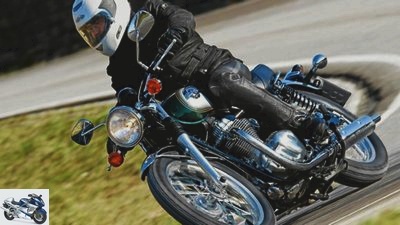
Gargolov
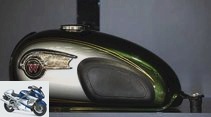
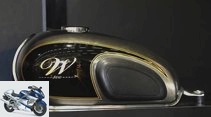
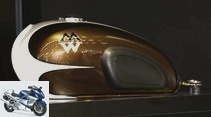
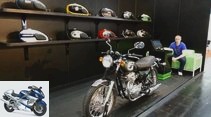
29 photos
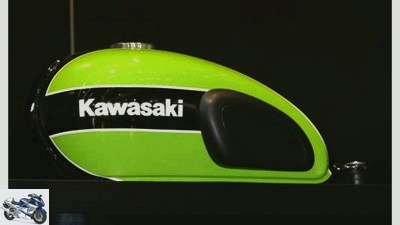
Sdun / Jahn / Kawasaki
1/29
Kawasaki W 800: different tank designs.
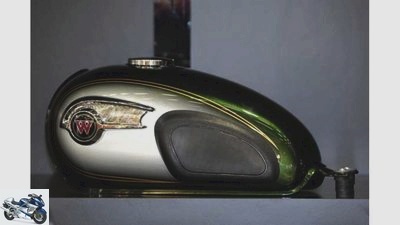
Sdun
2/29
Kawasaki W 800: different tank designs.
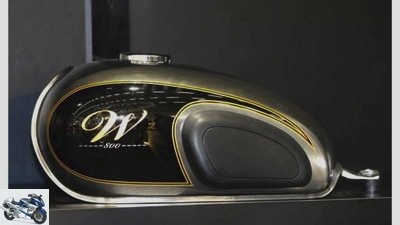
Sdun / Jahn / Kawasaki
3/29
Kawasaki W 800: different tank designs.
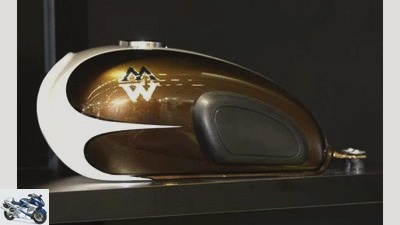
Sdun / Jahn / Kawasaki
4/29
Kawasaki W 800: different tank designs.

Sdun / Jahn / Kawasaki
5/29
Kawasaki W 800: A real eye-catcher at the exhibition stand are the various tank designs that Kawasaki is showing. Visitors can vote at a terminal which ones they like and which they don’t.
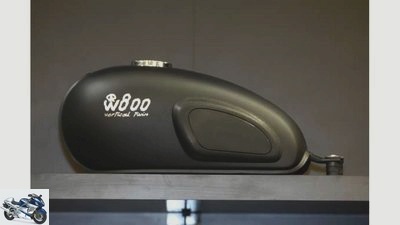
Sdun / Jahn / Kawasaki
6/29
Kawasaki W 800: different tank designs.
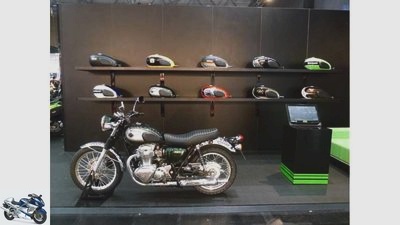
Sdun / Jahn / Kawasaki
7/29
Kawasaki W 800: different tank designs.

Sdun / Jahn / Kawasaki
8/29
Kawasaki W 800: different tank designs.
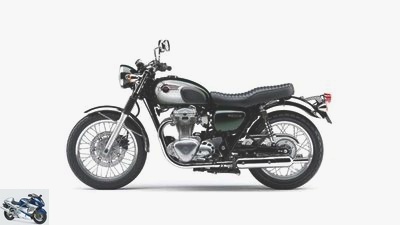
Sdun / Jahn / Kawasaki
9/29
… The predecessor E 650 cost just under 7,000 euros.
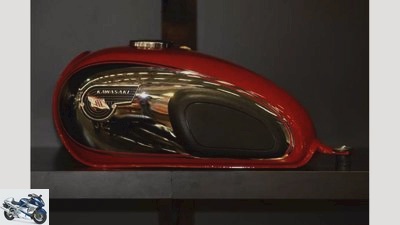
Sdun / Jahn / Kawasaki
10/29
Kawasaki W 800: different tank designs.
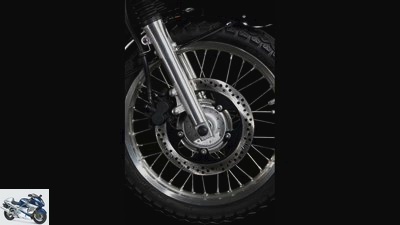
Sdun / Jahn / Kawasaki
11/29
Kawasaki W 800: Spoked wheel, bellows and – at least one – disc brake.
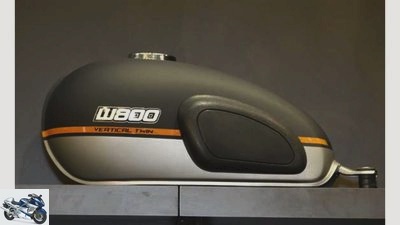
Sdun / Jahn / Kawasaki
12/29
Kawasaki W 800: different tank designs.
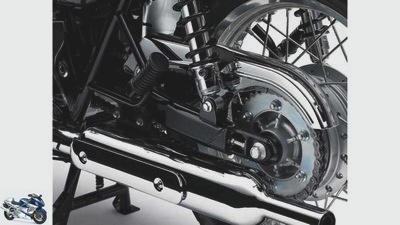
Kawasaki
13/29
The rear is decelerated by a drum brake. A real retro bike of course also includes classic looking struts.
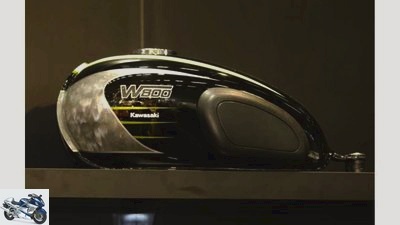
Sdun / Jahn / Kawasaki
14/29
Kawasaki W 800: different tank designs.
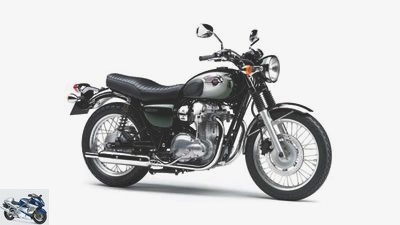
Sdun / Jahn / Kawasaki
15/29
Kawasaki W 800: Presentation at the Intermot.

Sdun / Jahn / Kawasaki
16/29
Kawasaki W 800: This sight only distracts from the beautiful cooling fins of the two-cylinder!

Sdun / Jahn / Kawasaki
17/29
Kawasaki W 800.
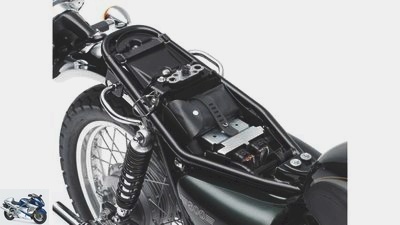
Sdun / Jahn / Kawasaki
18/29
Kawasaki W 800: A padlock fitted under the seat.
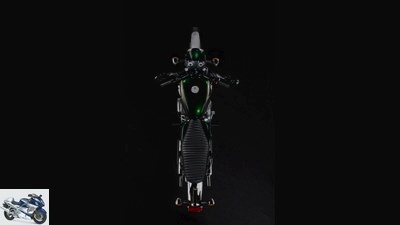
Sdun / Jahn / Kawasaki
19/29
Kawasaki W 800: Everything classic – from the instruments to the seat to the rear.

Sdun / Jahn / Kawasaki
20/29
Kawasaki W 800: different tank designs.
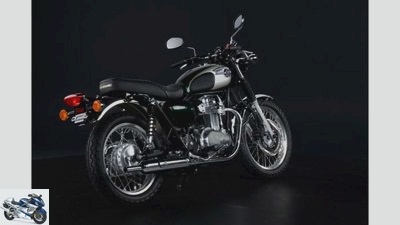
Sdun / Jahn / Kawasaki
21/29
Kawasaki W 800: The homologation has not yet been completed, but Kawasaki expects around 48 to 50 hp for Germany. A result that is due to the design for a lot of torque and the current emissions regulations.
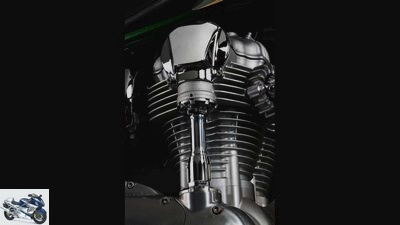
Sdun / Jahn / Kawasaki
22/29
Kawasaki W 800: the bevel is back.
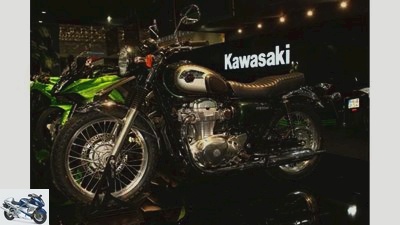
Sdun / Jahn / Kawasaki
23/29
With the W 800, Kawasaki succeeded in creating a real surprise at the Intermot.
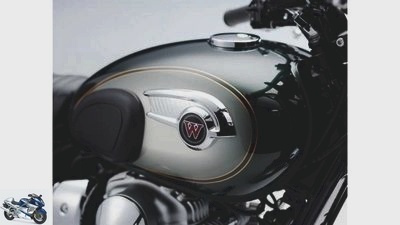
Sdun / Jahn / Kawasaki
24/29
Kawasaki W 800: The retro bike comes onto the market with this tank. At the Intermot, Kawasaki is also testing the visitor response to a wide variety of designs – see pictures at the end of this photo show.
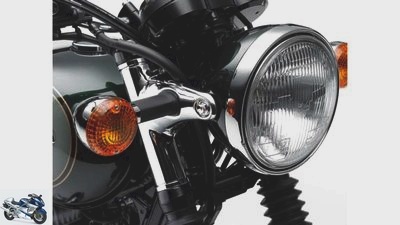
Sdun / Jahn / Kawasaki
25/29
The Kawasaki W 800 is to commemorate the W1, one of the first motorcycle models from Kawasaki.
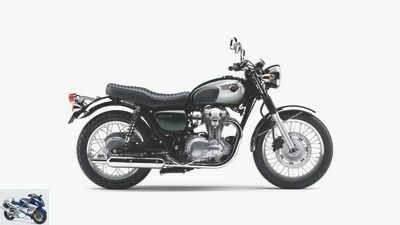
Sdun / Jahn / Kawasaki
26/29
Kawasaki W 800: The price has not yet been determined, …

Sdun / Jahn / Kawasaki
27/29
Actually a beautiful sight, …
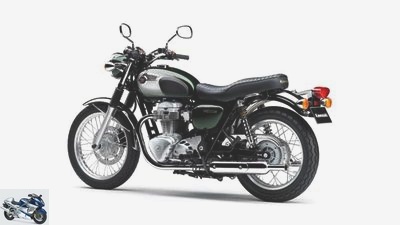
Sdun / Jahn / Kawasaki
28/29
Kawasaki W 800: After the W 650 was taken out of the range, the Japanese retro fans are again offering a nice motorcycle.
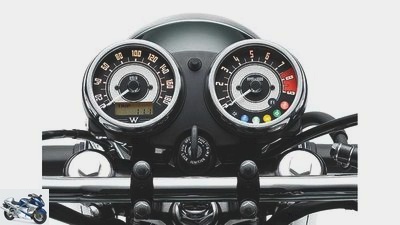
Kawasaki
29/29
… only the numbers of the instruments do not fit into the picture.
Test: Kawasaki W 800
The vertical shaft Kawasaki W 800 in the spirit of the 1960s
From the land of the rising bliss, Kawasaki sends us a motorcycle that combines grace and style. The W 800 is a feast for the eyes with a vertical shaft in the true 1960s spirit.
Southern Germany, February 2011. A very blue sky spans hills and valleys like a huge dome. Does the long-awaited spring already let its bonds flutter here? This warmth, this sun. Or does something completely different make your heart feel so warm and cozy? In the form of grace and style in its purest form. Authentic, tasteful, appealing, that’s what it says Kawasaki W 800 as the successor to the blessed 650 series. Classic with vertical shaft, cooling fins, because air-cooled, and spoked wheels. An aura surrounds this motorcycle like a coat. It is a real feast for the eyes, an experience that goes under the conjunctiva.
Buy complete article
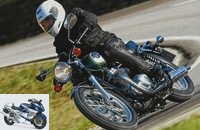
Test: Kawasaki W 800
The vertical shaft Kawasaki W 800 in the spirit of the 1960s
W 800 is highly communicative, it will help "open" Rhinelanders are likely to trigger spontaneous crowds. The questions are always the same: which brand, how old, how long has it been restored? Well, Kawasaki is not that easy to spot because it’s just a fat one "W." emblazoned in the midst of the sweeping, chrome-plated tank emblems. Nobody wants to believe that the machine is brand new and has not yet run 1000 kilometers.
Gargolov
Frankly: Kawasaki could have done more with the cladding and wiring of the injection system.
Only the whirring of the fuel pump when turning the ignition key, that would not have happened before. The 800 has injection. And therefore no Kickstarter, in contrast to the carburettor-equipped W 650 presented in 1999, on which it is based. So don’t line up, just press a button. Choke was also earlier. The parallel twin, measuring 773 cm3, wakes up with a whisper, bubbling quietly, inconspicuously from the overly motivated, weeping silencers. So not at all like a machine from the Roaring Sixties. The pistons, which now measure 77 millimeters, run synchronously back and forth between the dead centers, 83 millimeters as usual. As a result, the 800 series engine drives five millimeters more bore and five millimeters more than the deep stacking 650 with the same stroke "just" 97 cm3 more displacement.
This results in a tangible difference in character: the old unit was even longer stroke in relation to the bore. And came across just like that, a tad more casual. Bubbling up from the lowest idle speeds, celebrated the 650 twin even more impressively. The 800 cc engine doesn’t seem strained, but it’s also not really easy to revving. Objectively speaking, it has more power than the old one. Only 48 HP nominal power, at one time it was 50, comply with the upcoming driving license regulations. In real terms, it is 49 hp and a maximum of a meager 62 Newton meters of torque. But performance is relative here. You move. And how! Thanks to an upright driver posture, you are constantly discovering new things even on the home route.
Park your knees on somewhat hard knee cushions, as was customary for old fathers, the handlebars fit like a glove in height and width. And the slightly stepped, ribbed bench is comfortable and cut nice and narrow in the front area. Relaxation and deceleration shake hands. Let the representative types jostle in their TDIs. No, with the W 800 you get out of the way, renounce performance mania and horsepower swagger. Soft, very soft, you can feel the elastic parallel twin pulsing.
That pearls! The vertical shaft on the right exclusively drives the overhead camshaft, which in turn drives four valves per cylinder. At the top, from 4000 rpm, especially on the track, the kawa’s tingling sensation can also be annoying. It is your own fault who hangs around 7000 tours shortly before the red area.
Gargolov
Photo show: Presentation of the new Kawasaki W 800.
The W chassis is just as good-natured. Anyone who has their tricycle under control as a toddler will get along just fine with the Kawasaki weighing 217 kilograms. She spontaneously inspires confidence. Narrow tires, 100 and 130 millimeters wide, rotate on their 19-inch rim at the front and the 18-inch model at the rear. It is easy to tilt on it. As predictable as a sextant at sea, the Kawa circles the curves on land. If the notches scratch, you willingly let it go. Because this old-fashioned driving experience is simply lively. The Dunlop Roadmaster GP tires are great. Because they sound so wonderfully like old times, like Norton Roadholder forks. In addition, they look bold, scrambler-like, with a rather coarse profile.
The Roadmasters stick very well even on the most wet roads – it’s still February after all. And if it gets too much, they announce possible slides in good time. Man and machine, tires and chassis can even cope with smaller dirt roads. The fork springs and dampens finely enough, the comfortable, but slightly underdamped struts swing happily. So what? This leaves room for Ikon, formerly Koni, with its great youngtimer struts. In the worst-case scenario, you’ll have to pull the hand lever of the blunt front brake quite a bit. The double-piston floating caliper bites the single disc toothless. A kind of mechano-hydraulic ABS. At least the stylish drum brake at the rear offers decent support.
Many details of the popular figure on wheels are beautiful and well thought out. In addition to the two-tone paint, the very simple helmet lock, main stand and plenty of luggage hooks shine. Both hand levers are adjustable and, in keeping with the latest technology, two throttle cables have been relocated, one to open and one to close the 34th primary throttle valve. The on-board computer controls the secondary flaps. A liquid crystal clock in the cockpit and a cranked valve on the rear wheel make life easier. And the price? 8,360 euros. That sounds like a lot for a motorcycle with few superlatives. When the W 650 phased out in 2005, it cost a good 1500 euros less. Since then, their used prices have risen sharply. Classic from the box hit a nerve. In this respect, 8360 euros are appropriate for happy, nostalgic moments, for wave movement in the form of the Kawasaki W 800.
Click here for the video of the presentation at Intermot:
Technical specifications
Gargolov
A picture of a motorcycle with a 1960s aesthetic.
engine:
Air-cooled two-cylinder four-stroke in-line engine, a balance shaft, an overhead camshaft driven by a bevel shaft, four valves per cylinder, rocker arm, wet sump lubrication, injection, Ø 34 mm, regulated catalytic converter, battery 12 V / 12 Ah, mechanically operated multi-plate oil bath clutch, five-speed gearbox, O -Ring chain, secondary ratio 40:17.
Bore x stroke 77.0 x 83.0 mm
Displacement 773 cm3
Compression ratio 8.4: 1
rated capacity 35.0 kW (48 hp) at 6500 rpm
Max. Torque 60 Nm at 2500 rpm
landing gear:
Double loop frame made of steel, telescopic fork, Ø 39 mm, two-arm swing arm made of steel, two spring struts, adjustable spring base, front disc brake, Ø 300 mm, double-piston floating caliper, rear drum brake, Ø 160 mm.
Spoked wheels with aluminum rims 2.15 x 19; 2.75 x 18
Tires 100/90 19; 130/80 18
Dunlop Roadmaster GP tires tested
Mass and weight:
Wheelbase 1465 mm, steering head angle 63.0 degrees, caster 108 mm, suspension travel f / h 130/106 mm, seat height * 800 mm, weight with a full tank * 217 kg, payload * 183 kg, tank capacity 14.0 liters.
guarantee two years
Service intervals 6000 km
colour Dark green metallic
price 8190 euros
Additional costs around 170 euros
Performance:
Top speed 170 km / h; Acceleration 0-100 km / h 6.1 seconds, 0-140 km / h 13.3 seconds, pulling 60-100 km / h 6.6 seconds, 100-140 km / h 9.8 seconds, fuel consumption 4.4 l / 100 km normal, range 318 km.
Related articles
-
Endurance test final balance of the Kawasaki ZX-10R
Bilski endurance test final balance sheet Kawasaki ZX-10R Too good to strip After 50,000 kilometers it is opened, looked inside and measured. So are the …
-
MOTORCYCLE Supersport Test 2011: Race Track
82 pictures Kuenstle 1/82 Easy to use traction control of the Aprilia. Kuenstle 2/82 A thoroughbred racing file with incredible …
-
Test: Funbikes from Ducati, Honda, Kawasaki, KTM and Triumph
Jahn 32 photos Jahn 1/32 Long distances are not a problem for the bikes – but they are just as suitable for the short after-work lap. Jahn 2/32…
-
BMW F 800 GT, Kawasaki Z 1000 SX and Honda VFR 800 F in the test
fact 44 photos fact 1/44 fact 2/44 fact 3/44 fact 4/44 fact 5/44 In praise of diversity: the three test candidates all want the same thing, but try to…
-
Honda Fireblade SP and Kawasaki ZX-10R in the test
Jahn 44 photos Jahn 1/44 When it comes to price-performance ratio, the Kawasaki ZX-10R can convince more. Jahn 2/44 Bye-bye screwed adjustment rings and…
-
Kawasaki Z 800, Yamaha MT-09 and BMW F 800 R in a comparison test
35 pictures 1/35 The center is no longer where it used to be. Because bikes with displacements around 800 cm³ count …
-
Kawasaki Z 800 versus Yamaha FZ8 in MOTORCYCLE group test
12 pictures 1/12 Yamaha FZ8 against Kawasaki Z800 in comparison test. 2/12 Clearly structured cockpit, but with …
-
Kawasaki Z 650 in the test (2018)
17 pictures 1/17 The Z 650 is very popular. This is not a coincidence, but the result of a …
-
BMW R 1200 RS and Kawasaki Z 1000 SX in a comparison test
r-photography.info 18th photos r-photography.info 1/18 BMW R 1200 RS and Kawasaki Z 1000 SX. r-photography.info 2/18 BMW R 1200 RS and Kawasaki Z 1000…
-
Jahn Top test Kawasaki ZRX 1200 R Greetings from Eddie The Kawasaki tradition of the strong in-line four-cylinder is not embodied as emphatically as the…